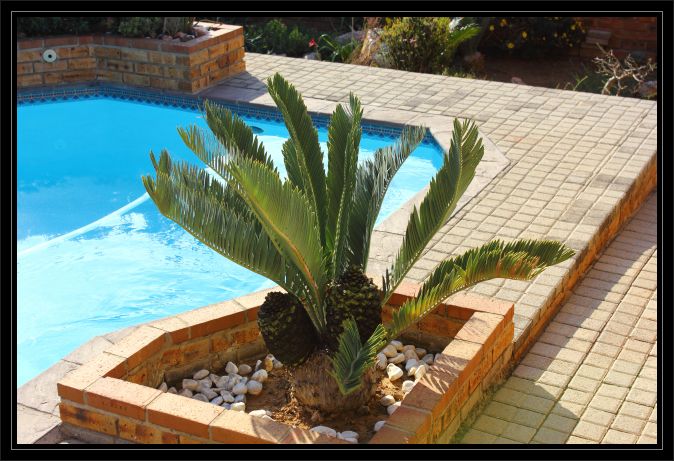
Though they are a minor component of the plant kingdom today, during the Jurassic period, they were extremely common. They have changed little since the Jurassic, compared to some major evolutionary changes in other plant divisions. The Jurassic period is sometimes called the “Age of Cycads” because they were so common. They were found all over the world but are now restricted to the tropical and sub-tropical areas.

Cycads are sometimes confused with ferns and palm trees but they are related to neither.
Two species, Encephalarthos and Stangeria are found only in Africa.
Stangeria is endemic to South Africa and consists of a single species that resembles a large fern.
S.eriopus – Eastern Cape and KwaZulu-Natal

Encephalarthos is the second largest in the cycad family, with 60 species and 37 of them occurring in the eastern part of South Africa
E. aemulans – KwaZulu-Natal
E. altensteinii - Eastern Cape
E. aplanatus – Eastern Swaziland
E. arenarius – Eastern Cape
E. brevifoliolatus – very rare, Northern Province
E. caffer – Eastern Cape
E. cerinus – rare, KwaZulu-Natal
E. cupidus – Mpumalanga
E. cycadifolius – Winterberg Mountains
E. dolomiticus – rare, Northern Province
E. dyerianus – rare, Northern Province
E. eugene-maraisii – Northern Province
E. ferox – KwaZulu-Natal
E. friderici-guilielmi – Eastern Cape and KwaZulu-Natal
E. ghellinckii – Drakensberg foothills
E. heenanii – rare, Mpumalanga and Swaziland
E. hirsutus – Northern Province
E. horridus – Eastern Cape
E. humillis – Northern Province
E. inopinus – Northern Province
E. laevifolius – rare, Mpumalanga, Northern Province and Swaziland
E. lanatus – Mpumalanga and Gauteng
E. latifrons – very rare, Eastern Cape
E. lebomboensis – Mpumalanga and KwaZulu-Natal
E. lehmannii - Karoo
E. longifolius – Eastern Cape
E. middelburgensis – rare, Mpumalanga
E. msinganus – rare, KwaZulu-Natal
E. natalensis – KwaZulu-Natal
E. ngoyanus – KwaZulu-Natal
E. nubimontanus – rare, Northern Province
E. paucidentatus – Mpumalanga
E. princeps – Eastern Cape
E. senticosus – KwaZulu-Natal and Swaziland
E. transvenosus – Northern Province
E. trispinosus – Eastern Cape
E. villosus – Eastern Cape to Swaziland
E. woodii – KwaZulu-Natal. Sadly it is now extinct in the wild.
This is just a brief history of our unique gentle giants
Duke and I fell in love with cycads while still living in Durban and we were given two tiny seedlings as a house warming gift. We started reading up about them and have never stopped being fascinated by them and collecting them.
This was our garden six years ago

Every time we have moved house the first plants we planted in the gardens were cycads.
To date we have moved seventeen times.
I would like to begin with the E. eugene-maraisii that is growing in the garden. We planted it five and half years ago. It is doing very well in the chosen spot- has grown quite quickly and has produced cones.

The only way to find out whether the plant is male or female is when it produces cones. The cones look very much like pine cones but much larger. The female cones are egg shaped and the male cones are narrow and long.
My E. eugene-maraisii is a female, I discovered, from the shape of the cones.
I had them pollinated and now am trying to germinate them.
Wish me luck!







